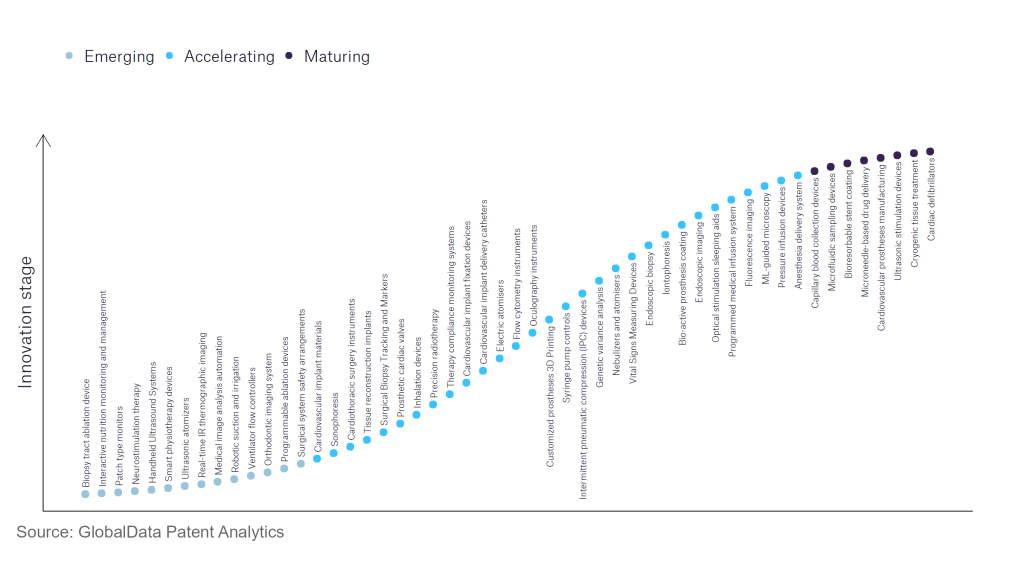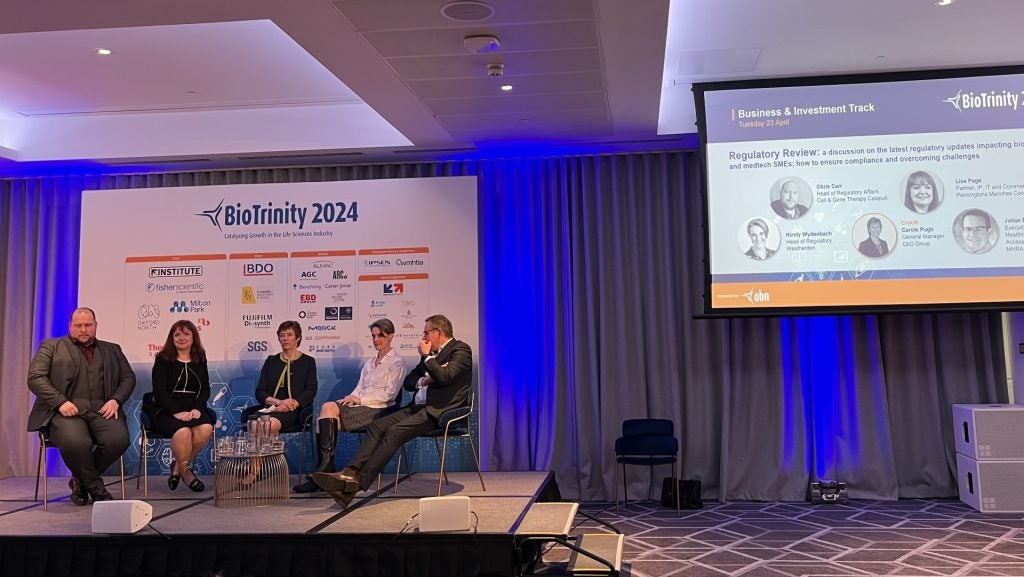The medical devices industry continues to be a hotbed of innovation, with activity driven by increased need for homecare, preventative treatments, early diagnosis, reducing patient recovery times and improving outcomes, as well as a growing importance of technologies such as machine learning, augmented reality, 5G and digitalisation. In the last three years alone, there have been over 450,000 patents filed and granted in the medical devices industry, according to GlobalData’s report on Innovation in Medical Devices: Biopsy tract ablation device. Buy the report here.
However, not all innovations are equal and nor do they follow a constant upward trend. Instead, their evolution takes the form of an S-shaped curve that reflects their typical lifecycle from early emergence to accelerating adoption, before finally stabilising and reaching maturity.
Identifying where a particular innovation is on this journey, especially those that are in the emerging and accelerating stages, is essential for understanding their current level of adoption and the likely future trajectory and impact they will have.
150+ innovations will shape the medical devices industry
According to GlobalData’s Technology Foresights, which plots the S-curve for the medical devices industry using innovation intensity models built on over 550,000 patents, there are 150+ innovation areas that will shape the future of the industry.
Within the emerging innovation stage, neurostimulation therapy, smart physiotherapy devices, and real-time IR thermographic imaging are disruptive technologies that are in the early stages of application and should be tracked closely. Precision radiotherapy, electric atomisers, and bio-active prosthesis coating are some of the accelerating innovation areas, where adoption has been steadily increasing. Among maturing innovation areas are bioresorbable stent coating and cryogenic tissue treatment, which are now well established in the industry.
Innovation S-curve for the medical devices industry

Biopsy tract ablation device is a key innovation area in the medical devices industry
Biopsy tract ablation device uses thermal energy to prevent the risk of complications such as seeding and bleeding after a biopsy procedure. Ablation can be performed using a variety of modalities such as lasers, radiofrequency, and other methods based on the patient indication. The ablation device may be effective in individuals with a bleeding propensity or ascites who require a liver biopsy for proper therapy.
GlobalData’s analysis also uncovers the companies at the forefront of each innovation area and assesses the potential reach and impact of their patenting activity across different applications and geographies. According to GlobalData, there are 20+ companies, spanning technology vendors, established medical devices companies, and up-and-coming start-ups engaged in the development and application of biopsy tract ablation devices.
Key players in biopsy tract ablation device – a disruptive innovation in the medical devices industry
‘Application diversity’ measures the number of different applications identified for each relevant patent and broadly splits companies into either ‘niche’ or ‘diversified’ innovators.
‘Geographic reach’ refers to the number of different countries each relevant patent is registered in and reflects the breadth of geographic application intended, ranging from ‘global’ to ‘local’.
See Also:
Patent volumes related to biopsy tract ablation device
| Company | Total patents (2010 - 2022) | Premium intelligence on the world's largest companies |
| Waters | 184 | Unlock Company Profile |
| Medtronic | 159 | Unlock Company Profile |
| Johnson & Johnson | 67 | Unlock Company Profile |
| Olympus | 54 | Unlock Company Profile |
| Creo Medical Group | 42 | Unlock Company Profile |
| Koninklijke Philips | 29 | Unlock Company Profile |
| Broncus Medical | 23 | Unlock Company Profile |
| Intuitive Surgical | 20 | Unlock Company Profile |
| Illumigyn | 19 | Unlock Company Profile |
| Procept Biorobotics | 15 | Unlock Company Profile |
| Blossom Innovations | 12 | Unlock Company Profile |
| Boston Scientific | 12 | Unlock Company Profile |
| Bristol-Myers Squibb | 11 | Unlock Company Profile |
| Cardioguidance Biomedical | 10 | Unlock Company Profile |
| Abbott Laboratories | 9 | Unlock Company Profile |
| Becton Dickinson and Co | 9 | Unlock Company Profile |
| Canon | 8 | Unlock Company Profile |
| Gynesonics | 7 | Unlock Company Profile |
| Autonomix | 7 | Unlock Company Profile |
| Rfemb Holdings | 6 | Unlock Company Profile |
| Custom Medical Applications | 5 | Unlock Company Profile |
| ERBE Elektromedizin | 5 | Unlock Company Profile |
Source: GlobalData Patent Analytics
Waters and Medtronic are two of the leading patent filers in the biopsy tract ablation devices. Other leading patent filers include Johnson & Johnson, Olympus, and Creo Medical Group.
In terms of application diversity, Bristol-Myers Squibb leads the pack, followed by Waters and Custom Medical Applications. By means of geographic reach, Gynesonics held the top position, followed by Rfemb Holdings and Bristol-Myers Squibb in second and third spots, respectively.
Advances in ablation techniques combined with other treatment modalities like radiotherapy and chemotherapy will enhance the feasibility of treatment interventions and patient survival rates. If the biopsy tract ablation device is utilised correctly considering its potential benefits, it may assist to lessen the risk of problems associated with biopsy.
To further understand the key themes and technologies disrupting the medical devices industry, access GlobalData’s latest thematic research report on Medical Devices.
Premium Insights
From

The gold standard of business intelligence.
Blending expert knowledge with cutting-edge technology, GlobalData’s unrivalled proprietary data will enable you to decode what’s happening in your market. You can make better informed decisions and gain a future-proof advantage over your competitors.




